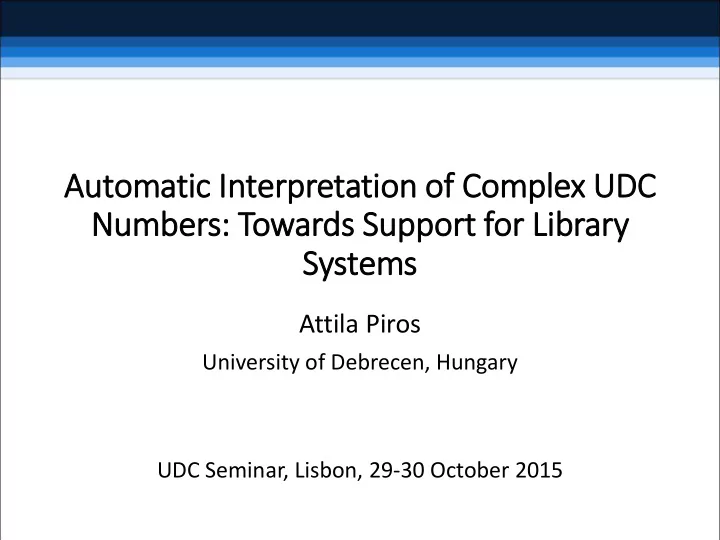

Automatic In Interpretation of f Complex UDC Numbers: : Towards Support for Li Library Systems Attila Piros University of Debrecen, Hungary UDC Seminar, Lisbon, 29-30 October 2015
Goal • Supporting software systems to utilize Universal Decimal Classification to retrieve information effectively: • Find a way to represent each language units of simple and complex UDC numbers in an easy processable format by keeping all of the information stored in the numbers • Create an algorithm and implement a reference application to interpret UDC numbers by automatic means • Develop and implement conversion methods to different formats
The representation of UDC numbers • The usual structure of a ‘simple’ UDC number: [main table number/range][special auxiliaries][dependent common auxiliaries][independent common auxiliaries (containing numbers/ranges, special auxiliaries and mayhap operations)] • Compound (or ‘ complex ‘ ) UDC numbers are built from ‘simple’ numbers by using auxiliary signs • Subgrouping can be used to clarify the order or modify compounds by auxiliaries
The representation of UDC numbers • After investigating the definitions of the operations the following precedence order can be defined: • + Coordination • : Simple relation • :: Order-fixing • [ ] Subgrouping • ' Synthesis (within special auxiliaries) • Every UDC number can be represented with a tree • It is possible to define a schema definition to determine the exact format to describe the numbers in XML
The representation of UDC numbers • The complex types of the XSD describe the possible elements of UDC numbers, e.g. schedule numbers : <xsd:complexType name=" special_auxiliary_number_hyphen "> <xsd:complexContent> <xsd:restriction base="udc:special_auxiliary_number"> <xsd:attribute name=" number1 “ type="udc:special_auxiliary_number_hyphen_string “ use="required"/> <xsd:attribute name=" number2 " type="udc:special_auxiliary_number_hyphen_string" use="optional"/> </xsd:restriction> </xsd:complexContent> </xsd:complexType>
The representation of UDC numbers • A common auxiliary sign (operation) can be described by a complex type containing its possible operands: <xsd:complexType name=" main_table_relation "> <xsd:sequence> <xsd:choice minOccurs=" 2 " maxOccurs=" unbounded "> <xsd:element name=" main_table_number " type="udc:main_table_number" minOccurs="1" maxOccurs="1"/> <xsd:element name=" main_table_synthesis " type="udc:main_table_synthesis" minOccurs="1" maxOccurs="1"/> <xsd:element name=" main_table_subgrouping " type="udc:main_table_subgrouping" minOccurs="1" maxOccurs="1"/> <xsd:element name=" main_table_orderfixing " type="udc:main_table_orderfixing" minOccurs="1" maxOccurs="1"/> </xsd:choice> </xsd:sequence> </xsd:complexType>
The representation of UDC numbers • Simple types have been introduced for validation purposes: <xsd:simpleType name=" special_auxiliary_number_hyphen_string "> <xsd:restriction base="xsd:string"> <xsd: pattern value="-\d(\d{0,1}|(\d{2}(\.[1-9]\d{2})*(\.[1- 9]\d{0,2})?))"/> <xsd: minLength value="2"/> </xsd:restriction> </xsd:simpleType>
The automatic in interpretation of UDC numbers • Converting UDC numbers manually to a complex format such as that mentioned earlier is an unrealistic expectation • The existing records should also be processed and converted • The UDC number itself is a common and stable element of the varying formats
The automatic in interpretation of UDC numbers • Has been researched for about 50 years • A comprehensive research was conducted by Gerhard Riesthuis (Zoeken met woorden, 1998) • In the course of this research, a new algorithm has been created, which is better suited to the XML schema and the principles which will be explained on the next slide
The automatic in interpretation of UDC numbers • The algorithm must recognize those numbers which keep to the rules for synthesizing UDC numbers • The algorithm must retain all of the information stored by the number, containing all of its parts and the information pertaining to their context and role • The parsing method must be fully syntactic as far as is possible • The process must be fully automated
The automatic in interpretation of UDC numbers • Online availability and providing outputs in different formats are also important expectations • The software is available online for testing purposes on the following URL: http://interpreter-eto.rhcloud.com/
The automatic in interpretation of UDC numbers • 821.111SHAK7ROM.03=112.2 <ns:udc_concept xmlns:ns="http://library.inf.unideb.edu/udc/xml" xmlns:xsi="http://www.w3.org/2001/XMLSchema-instance" udc_edition="2005" notation=" 821.111SHAK7ROM.03=112.2 "> <ns:description xml:lang="EN"> Shakespeare: Romeo and Juliet (translated into German) </ns:description> <ns: main_table_number number1="821.111"> <ns: special_auxiliary xsi:type="ns:special_auxiliary_number_numerical" umber1="7"/> <ns: special_auxiliary xsi:type="ns:special_auxiliary_number_pointnought" number1=".03"/> <ns: alphabetical_specification order ="1" text="SHAK" standard=""/> <ns: alphabetical_specification order ="2" text="ROM" standard=""/> <ns:common_auxiliary_independent xsi:type="ns: common_auxiliary_of_language " order="1"> <ns:common_auxiliary_of_language_number number1="=112.2"/> </ns:common_auxiliary_independent> </ns:main_table_number> </ns:udc_concept>
The automatic in interpretation of UDC numbers • 061.1(100)::[54+66] <ns:udc_concept xmlns:ns="http://library.inf.unideb.edu/udc/xml" xmlns:xsi="http://www.w3.org/2001/XMLSchema- instance" udc_edition="2005" notation="061.1(100)::[54+66]"> <ns:description xml:lang="EN"> IUPAC - International Union of Pure and Applied Chemistry </ns:description> <ns: main_table_orderfixing > <ns:main_table_number number1="061.1" order ="1"> <ns:common_auxiliary_independent xsi:type="ns:common_auxiliary_of_place"> <ns:common_auxiliary_of_place_number number1="(100)"/> </ns:common_auxiliary_independent> </ns:main_table_number> <ns: main_table_subgrouping order ="2"> <ns: main_table_addition > <ns:main_table_number number1="54"/> <ns:main_table_number number1="66"/> </ns:main_table_addition> </ns:main_table_subgrouping> </ns:main_table_orderfixing> </ns:udc_concept>
The conversion of the result lts • KWOC-outputs in JSON and HTML (have been available since August): • 394.4:[92(100+437):329(437).15(091)+327.32(100)], JSON • 394.4:[92(100+437):329(437).15(091)+327.32(100)], HTML • 510.2/.6, HTML
The conversion of the result lts • Standardized numbers (has been available since October): • 622(437.3)333/.336-022.316=162.3(043) • 659.131.7.03:070.485 • 821.111(73)-32=511.141(082) • 821.111(73)-32=511.141(082) (by keeping citation order)
The conversion of the result lts • Supporting the further formats are planned and under design (but have not been published yet) • RDF/SKOS • MARC
The conversion of the result lts 37 skos:broader 37:004 skos:broader skos:broader 004 skos:related 439 [37:004] (439)=511.141=111 =511.141 skos:related rdf:seq skos:related =111
Recommend
More recommend